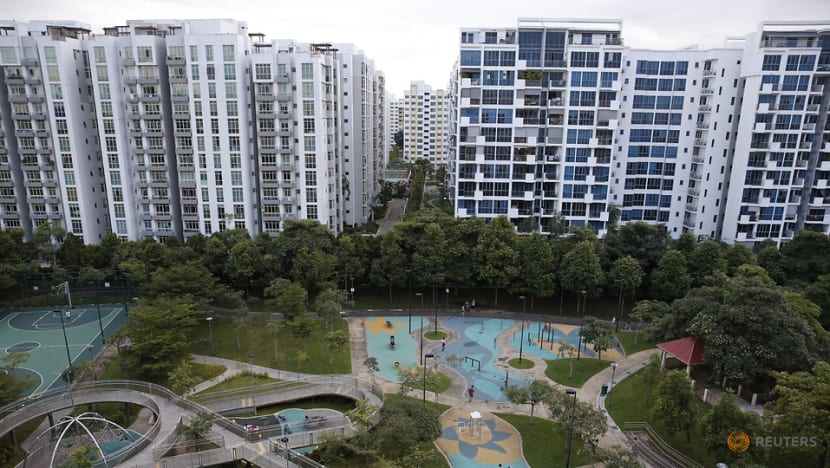'Fair wear and tear' disputes over rental property: What can tenants and landlords do?

A view of private residential homes and executive condominiums in Singapore. (File photo: Reuters)
SINGAPORE: After seven years in Singapore, Ms Ngo was excited to take on new opportunities in Canada, along with her husband and baby.
But issues with their landlord arose when they ended their two-year lease for a rental flat in Singapore.
Out of their S$3,600 two-month deposit, their landlord withheld about S$2,000 for damage to the flat, as well as the cost of deep cleaning and a prorated agent’s fee.
Some of the damage cited included sink crack lines, tile discolouration and kitchen top stain.
According to Ms Ngo, who did not want to reveal her full name, the landlord also pointed out the need to replace the toilet bowl seat, cooker hood bulb and repair a toilet light.
“I was very shocked that when we hand(ed) over, (the landlord) was very demanding,” she told CNA over the phone from Canada.
She and her husband are disputing several of the issues as “fair wear and tear”.
According to property agents and lawyers, fair wear and tear refer to damage to the property through ordinary use of the premises.
This could include furniture being worn out at the edges, scratches and marks on parquet flooring, fading of curtain colours under sunlight, as well as oil and fume stains in a kitchen hood.
READ: 8 useful tips to make the renting process stress-free for tenants
“A landlord cannot deduct the cost of these things from the deposit as it would be unreasonable to expect the property to be in exactly the same condition at the end of a tenancy as it was at the beginning,” said Ms Victoria Lee Soo Pin, a counsel at IRB Law.
However, issues like a burned or badly stained carpet, a lost key or a stain on the ceiling caused by an overflowing bath or sink can be claimed from the deposit, she added.
If a dining chair that is part of a set is “irreparably broken”, the landlord could claim for the cost of replacing a single chair, said Ms Lee. But the landlord may not claim the cost of the whole set.
RESPONSIBILITIES OF TENANTS AND LANDLORDS
IRB Law sees about 50 to 60 cases a month involving landlords and tenants, Ms Lee said.
She added that common issues are about “real damage” caused to the rental property, as well as landlords refusing to return tenancy deposits for issues such as broken items and odours in the house.
“In fact, we see more cases of actual damage where the equipment breaks down, such as the air-conditioner, washing machine, TV, big-ticket items during the course of the tenancy,” she said.
Another common area of dispute is cleaning, as it can be a “subjective issue”, she added. “Some instances of fair wear and tear can be improved with a good clean.”
Ms Lee noted that tenancy agreements would usually state that a property must be cleaned to a professional standard when a tenant checks out. While this standard may vary according to the property's original condition, this generally means cleaning to a “very high standard”, she said.
When returning a property, tenants should present a detailed invoice from the cleaner to prove that they have cleaned the house, Ms Lee said.
READ: Renting in Singapore: The most common reasons a landlord might reject you
Sometimes, tenants misunderstand their responsibilities, said Ms Lee. For instance, tenants are generally responsible for replacing light bulbs when they leave.
As for landlords, some of them think they can use the tenant’s deposit to make general repairs.
“The deposit belongs to the tenant and should be returned to the tenant at the end of the tenancy. Any deductions to tenancy deposits should be discussed and agreed on by both parties,” she said.
HOW TENANTS AND LANDLORDS CAN PROTECT THEMSELVES
According to Ms Ngo, she had inspected the house before moving in, but “not so much” as it came without any furniture.
“In the past, I usually had problems with the landlord’s furniture. I never had any problem with the wall, toilet sink or anything like that … so I wasn’t paying a lot of attention since the unit came without any furniture,” she told CNA.
She did not take many photographs either, as it “wasn’t anything obvious” or were not things she usually paid attention to. As such, she does not have photos of the items or issues she is disputing with her landlord.
Disputes over fair wear and tear is a “common problem”, said Propnex key executive officer Lim Yong Hock. “It can be a common issue, especially if they were not very specific at the point of handover.”
There are two reports at the point of handover, said KnightFrank property agent Alvin Yeo. The condition report should be as descriptive as possible and backed up with pictures.
When tenants move in, it is best for them to take many pictures and send them to the landlord to make sure they acknowledge the condition.
For any incidents that happen midway through the tenancy, tenants should flag it immediately, he added.
It is also important for tenants, landlords and agents to set expectations for any potential damage, said Mr Yeo.
He noted, for instance, a common dispute concerning walls that have scuffs near electrical switches. Some landlords might expect tenants to repaint the whole wall or even the whole house.
READ: Renting in Singapore? Here are 5 budgeting steps that are often overlooked
“So it’s best to clarify this at the beginning of the tenancy agreement - the walls, do you expect me to repaint the whole place, or can I return it to you with some scuffs?,” said Mr Yeo.
He gave another example of parquet flooring. While it is normal for some blemishes to appear after a while, some landlords might expect the floor to be in “showroom condition”, he said.
Chemical cleaning of air-conditioning units could be another source of dispute.
“So maybe it’s good that everyone comes up with a checklist and say that these are all the potential pitfalls, we better clarify,” he said.
The tenancy agreement should outline key issues so that tenants are fully informed, said Ms Lee. “The tenants should be clear as to what they can and cannot do.”
A good property agent should also warn tenants in advance on what constitutes misuse, she added.
AGENT’S ROLE
When Ms Ngo and her husband received the charges for the damage, they tried to explain the situation to the agent, saying some of the materials were more susceptible to stains.
She said that although they tried to negotiate to split some of the cost, especially for wear and tear, the landlord was unwilling to change his position.
Ms Ngo then told the agent that she engage a third party to mediate, and that they would file a claim at the Small Claims Tribunal.
“From that point on, he just stopped all communication with us. He didn’t read any of our WhatsApp messages, which was our only means of communication. When we tried to call through WhatsApp, he didn’t answer,” she said.
READ: How much should you spend on rent in Singapore?
According to Propnex’s Mr Lim, agents are under no obligation to resolve disputes between tenants and landlords.
“The duty of the agent, according to CEA (Council for Estate Agents), ends after we hand over the premises to the parties,” he said, adding that such disputes are usually resolved without the agent.
However, agents might get involved when tenants or landlords write to the authorities to complain about the agent, he noted.
In Mr Yeo’s experience, the agents “usually (end up as) the punching bag”, and they will have to manage the expectations on both sides.
WHAT TO DO DURING A DISPUTE?
When tenants and landlords get into a dispute, they can go to the Small Claims Tribunal or try mediation, said Mr Yeo.
There is no way for agents to help with resolving disputes, said Mr Lim, adding that agents usually refer parties to an independent mediator.
There are several factors tenants should consider if they disagree with their landlords’ assessment of damages to the property, said Ms Lee.
This includes the age and condition of the property at the start of the tenancy, the length of a tenancy or lease and the number of people living in the property.
For example, wear and tear during a five-year tenancy will be greater than a six month period, and a family of five with young children will inflict more wear and tear than a young professional couple out working most of the day, she said.
If there is damage to the property, the landlord should see if it is possible to repair or clean the item first, rather than disposing of the item to make the tenant pay for a new one.
In cases where an item needs to be replaced, the landlord should not replace the item with a better one, as they are not supposed to make a profit from it, said Ms Lee.
“It is down to the landlord to prove that the tenant has damaged the item through misuse. This might involve getting contractors to ascertain whether there is misuse and giving a quote to repair the damage,” she added.
“If parties are still in conflict, see if it is possible to have a third party such as the property agent who rented the unit act as the go-between."














